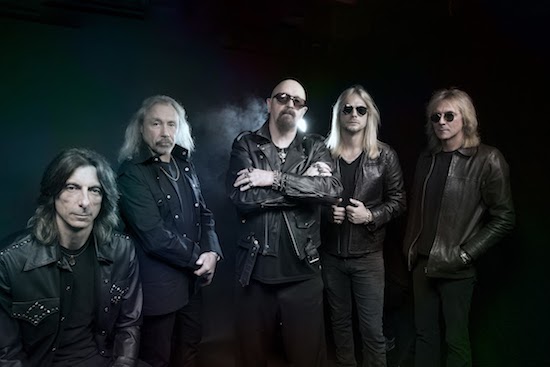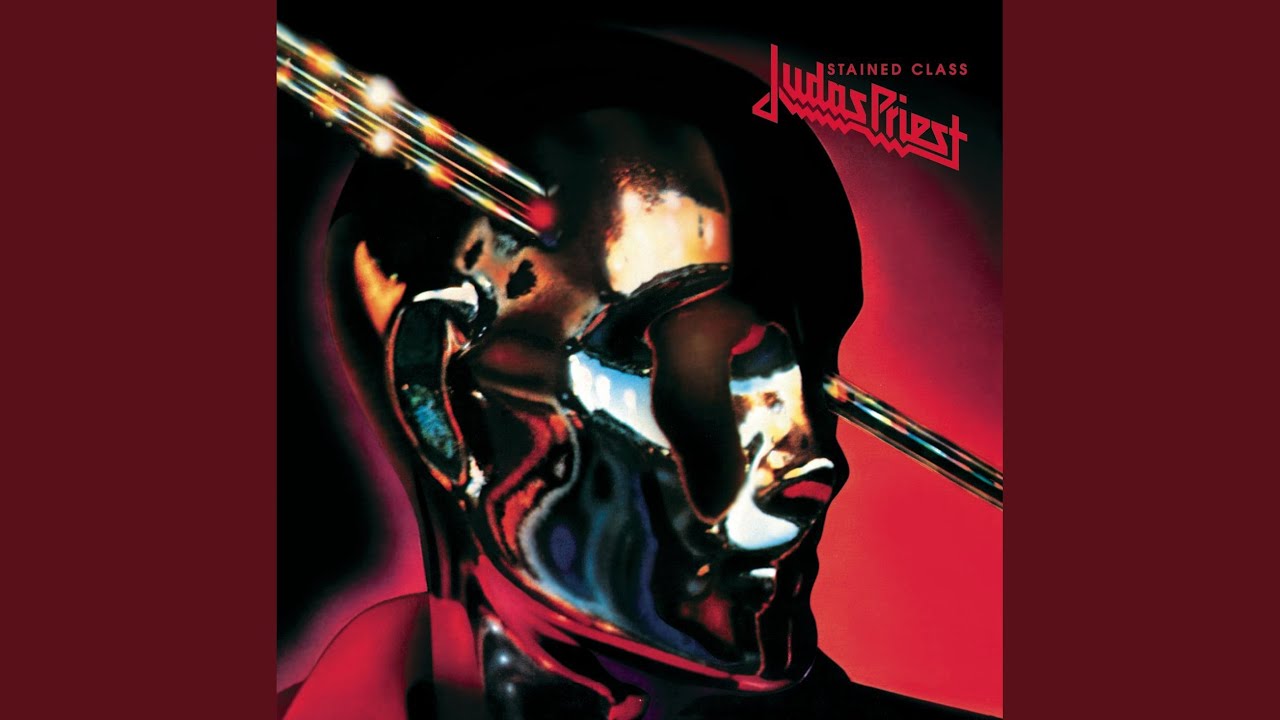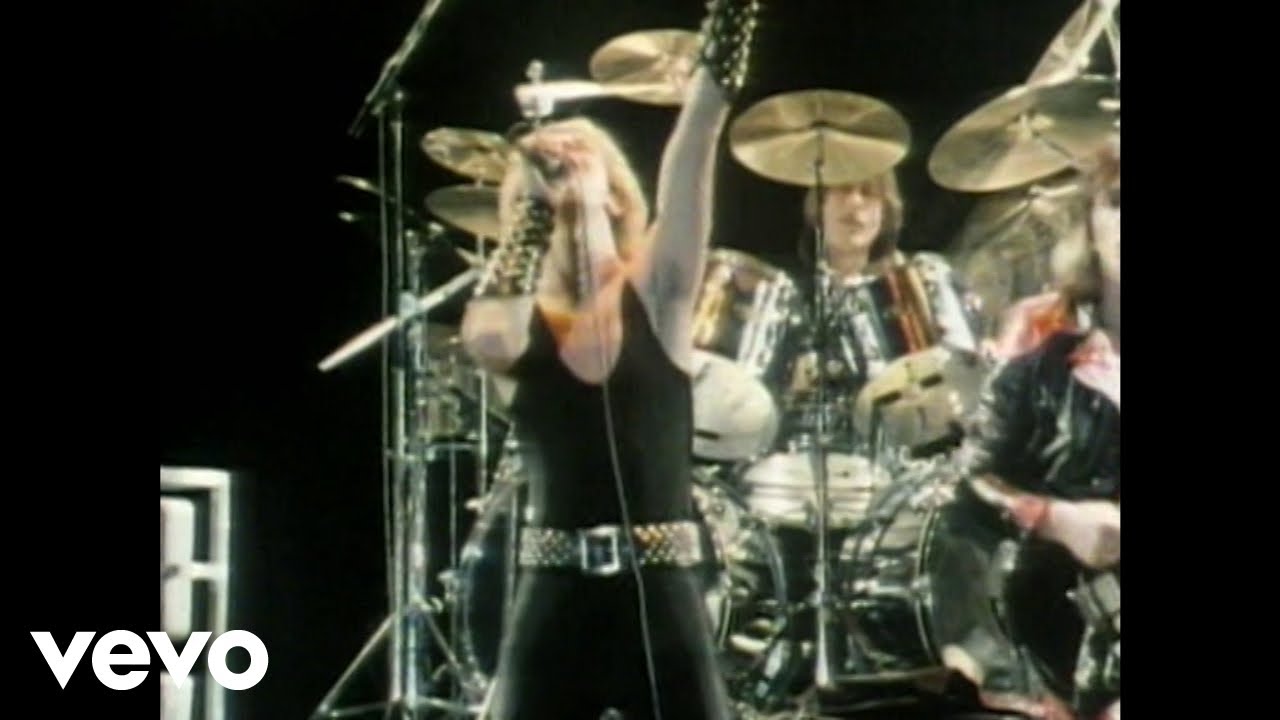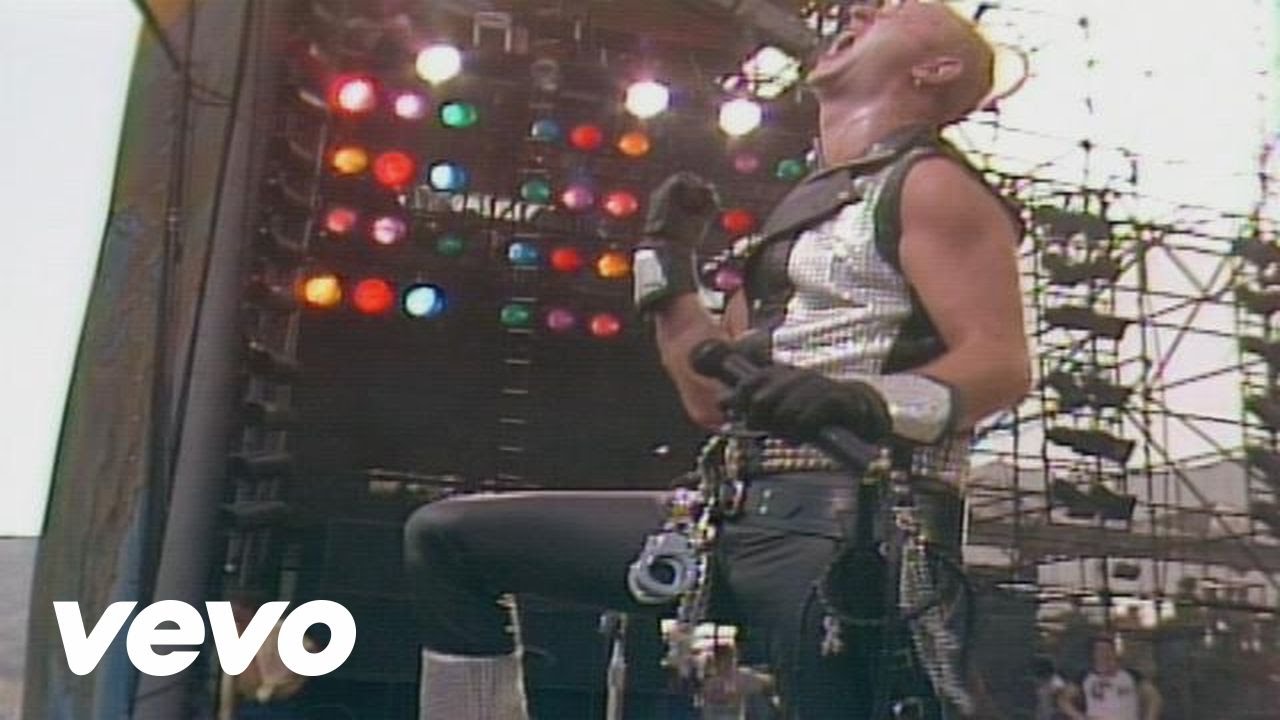Judas Priest today: fifty not out
It’s perhaps hard to comprehend at this distance, but Judas Priest might just be the most important band in the history of heavy metal. These days, they appear as old reliables – Rob Halford is, in his own words, “the stately homo of heavy metal” as much as the Metal God these days; they’re good for a headline slot at Bloodstock and capable of filling theatres, but not stadiums like their old students Iron Maiden – but in the late 1970s and early 1980s, Priest pretty much single-handedly drew up the template for what a metal band should look like and sound like.
It was not an accident. Where the previous generation of metal forefathers had all claimed to be heavy rock or blues rock or just plain old rock, Priest seized the concept of heavy metal for themselves and incorporated it into everything they did. Take KK Downing and his Flying V guitar.
Downing bought his first Flying V for £500 in 1973 – a fortune – not because of the way it sounded, but because it represented something. “Everything else had smooth contours,” he says. “The Flying V didn’t. And the thing is, they were rare. They were like rocking horse shit. Expensive, you know? Everybody else was playing Gibson SGs – Clapton had done that for years – or playing Les Pauls. Blues players had done that for years. So all of these other guys were playing music on those guitars, and then I saw the Flying V, and I’m thinking, ‘That’s for me.’ Because what I’m doing is different, why would I want the same guitar that everybody else has?” What he wanted, he says, was a guitar that looked like “the music in my head”.
Or take the look, the black leather and studs that became adopted as the look of metal bands everywhere, and still – with modifications (metal dress is substantially less like fetish wear nowadays; the leather covers more skin, and the studs are less prevalent) – echoes down the years. While singer Rob Halford is usually credited with the look – not least because he brandished the whip, and he frequented the gay fetish shops from which most of the more outlandish gear was bought – it was Downing who first had the idea. “I think there was this feeling in a band of wanting to find unity, as far as the visual side. And Ken was the first one to adopt that change in what he was wearing, and it became something we all picked up from and developed, pretty much all at the same time,” Halford says.
Downing notes the difference between the bands he had grown up idolising – The Jimi Hendrix Experience, Cream – and Priest. They were individual superstars, he observes, and dressed as separate people. But black leather and silver studs became a way of presenting Priest as a collective. “It suddenly dawned on me that if we all looked the same, we would look stronger, not weaker, contrary to what I’d always thought. It was almost like one of those military films, where everybody’s got their own look, but they’re all a part of the platoon, you know? So I’m thinking, ‘They look fearsome together. They’re different, but they’ve got things in common.’ And I thought that that’s really the way we ought to go with metal.”
“I always reference ‘Hell Bent For Leather’, and that one time we went out on a bike – I think it was in Nottingham. Could have been Derby. It was just a spur of the moment thing. There was a bunch of bikers parked by the side of a pub,” Halford says. “I said, ‘Wouldn’t it be great if we could bring a bike out on stage?’ And I stuck on a James Dean/Marlon Brando-style leather motorcycle jacket and everything shifted that night as far as the visual perception of the band. That began to get more defined from Stained Class onwards. If you look at us on the sleeve photograph, in a couple of years we changed a lot. But that whole image shift is vital. It’s vital because it combined the look with the sound – that tough leather look with the whips and chains and all the other accoutrements. From that point on, if you saw another group dressed like that, you were pretty sure they were going to be a heavy metal band.”
If you want an example of the power of what Priest came up with, just ask Mantas, the original guitarist of Venom, who went to see Priest at Newcastle City Hall on 28 May 1979. “Life changing. Absolutely. That’s all I can describe it as – life changing,” he says. “At that point there was no extreme metal, so this was as hard and as heavy as you were getting. I remember walking out of Newcastle City Hall with excitement just pounding in my ears. When the band came on stage, that blond guitarist ran on and I was like, ‘Wow! That’s what I want to do!’ He was the epitome of the English heavy metal guitarist. The leather, the studs, the hair, the Flying V. I have got no shame in admitting I went to Paul Harvey Music in Newcastle city centre and I asked him to get me a Flying V. No way could I afford a Gibson so I got a CSL copy, white and red, exactly the same as KK’s. And then of course I went to Boots the Chemist and bought a bottle of bleach and that was it.”
Think, too, of the sound. From the 1978’s Stained Class album on, Priest refined the sound of metal, making it into something clean and sharp and hard – and with the incessant, revving engine sound of the palm muted guitar, the der-der-der-der-der, at the heart of it. “it’s just more edgy and percussive isn’t it, really?” Downing says. “As opposed to playing open chords. And also it just connects a lot of times with the beat and pushes it on.” Don’t forget, either, the double-pace kick drums of ‘Exciter’, a crucial prefiguring of thrash, more than a year before Motörhead tried the same thing on ‘Overkill’.
As Halford notes, the journey Priest made from their debut – the anaemic Rocka Rolla – through to Stained Class, their fourth album, was immense. Stained Class was even a massive step on from Sad Wings Of Destiny, their second record and first metallic album. “Most bands tend to define themselves in their first three releases,” Halford says. “And as far as the actual core elements of Priest go, that’s probably true. But the difference between Stained Class and Sad Wings is quite vast. It’s just a remarkable journey that all bands are on, as far as developing their sound. Priest never had lengthy discussions or went in for analysing what we were doing to any great extent. It’s just the way we were moving at that time in our career.”
Priest are currently in the midst of their 50th anniversary celebrations – marked initially by a photo book, Judas Priest: 50 Heavy Metal Years – which seems a little odd. It’s not in dispute that a band called Judas Priest formed in Birmingham in 1969. But that band split up the following year, only for the singer, Al Atkins, to reconvene a new band called Judas Priest, who played their first gig in 1971, with Downing and bassist Ian Hill on board. So the concept of a 50th anniversary seems nebulous at best. Certainly, Priest as the world understands the band didn’t exist until Halford joined in 1973.
“Rob was incredibly important,” Downing says. “I was the guy that did the hiring and firing every band goes through, that process of elimination. In an ideal world the sound I wanted for the singer had to be Ian Gillan on speed. When they did Deep Purple In Rock, that’s how a singer needed to sound, with the range and the high notes. So miraculously when Rob became available and basically came and lived on my doorstep – I mean how good does that get? It had to happen and it did. He’d got the high notes, the whole range. And so it just allows you just to add more dynamics into what you’re trying to do. He was gay, obviously, we knew that from the offset, he was artistic, he was great with words. He was well educated, he was flamboyant, he was artistic. I mean, Rob had worked in the theatre he suggested we go to Birmingham Rep, where they had all these alcoves with all these clothes that you could rent. Look at some of the flamboyant stuff that we wore in the early days – cavalier boots and whatever. We couldn’t afford to buy stage clothes, so we used to go down there and rummage through.”
Ready access to cavalier boots proved not to be Halford’s lasting gift to Priest, of course. That was his voice – the voice that brought metal the strangulated scream deployed in an almost operatic fashion. But he wasn’t the only transformative person in Priest’s ascension. Even after the leap Priest made with Stained Class, their sound was still tinny and thin. It was metal, but it wasn’t yet as heavy as it should have been. The heaviness when the band finally found the right producer, Tom Allom.
Allom first worked with the band on the 1979 live album Unleashed In The East, but their next studio album, British Steel, was the point at which Priest – the New Wave Of British Heavy Metal breaking around them, filled with bands who rightly regarded them as pioneers – became the embodiment of metal. The miracle about this landmark of metal is that Priest entered Starling Studios – the residential studio Tittenhurst Park near Ascot, owned by Ringo Starr – at the start of February 1980 with almost nothing written, and left the studio only a month later with the whole thing completed.
“They were at a point in their career where they were being very productive and very inventive, and Unleashed gave them a degree of success they hadn’t had in the United States before,” Allom says. “They were beginning to get the feeling that they were on to something. They were getting their music across and they had been working pretty hard on the road up to the recording of British Steel, so they hadn’t had a lot of time to write. It was just one of those magical four week periods when everything came together. It was quick – 28 days. We worked hard. We worked long hours. We were young. We could take the pace. It was a very productive process. I don’t really remember that we had much time to do anything except work.”
Halford agrees Allom’s contribution – he produced Priest for the following decade – was crucial. “It’s a unique album, in sound and production and engineering from Tom,” he says. “Tom made a very special record for Priest, really directing us to cutting away all the dead flesh from the songs and just getting them really, really precise to do the job they needed to do. Tom gave us some valuable insights into putting across the minimalist point of view to maximum effect. Sometimes bands are in that creative place, where things appear to come easily. But they don’t. It’s out of your control as far as the creative bursts of ideas you have, whether it’s Glenn Tipton waking me up in the night to write ‘Living After Midnight’, or the jams for ‘Stealer’ and ‘Rapid Fire’. A lot of it has to do with being there in the building together. When you’re writing, a lot of the stuff that happens when you’re not writing has an effect on the way you write. It’s that being with each other all the time, from when you wake up in the morning to when you go down the pub at night. All those elements. There has to be some harmony in all the chaos of making metal, and I think that had a great effect on us.”
Allom also had the imagination to add to the songs where necessary, creating memorable low-budget sound effects. “Everyone knows about the breaking glass in ‘Breaking The Law’,” he says. “That was smashing milk bottles on Ringo’s terrace. And the cutlery tray was famous. We wanted the sound of marching feet in ‘Metal Gods’. It wasn’t just a cutlery tray, actually. It was also the legs of mic stands, with the rubber feet taken off – you couldn’t just sample sound, you had to get in time with the music, because we didn’t have sophisticated sampling. And I thought, ‘What about some cutlery?’ so I got all the cutlery out of the kitchen drawer. It was a mixture of those two sounds. But there were other sounds, too: on ‘Metal Gods’ there was the sound of a whip, which was a guitar chord being slapped heavily onto a flight case and then heavily compressed. There was a laser beam, which was a billiard cue going through the air. It was fun doing sound effects in those days.”
It would have been easy for Priest to lose their way in the early 80s, as so many metal bands did in the wake of the vast American success of Def Leppard, when scores of bands were steered towards a softer, more melodic sound by managements and labels with silver dollars for eyes, derailing their careers in the process. Priest, admittedly, tried for something a little more radio-friendly on 1981’s Point Of Entry, but the album that took them into the arenas of America was as hard and heavy a record as a major-label metal band had made to that point.
“Screaming for Vengeance, especially with ‘Riding On The Wind’ and the title track, that’s pretty intense,” Halford says. “There were some very very strong statements in that album.” One key statement was the opening pairing of the short instrumental ‘The Hellion’ and ‘Electric Eye’, a song about surveillance-based dictatorship whose chilly, robotic metal prefigures some of what Queens Of The Stone Age would try to do 20 years later. And then there was the radio hit, ‘You’ve Got Another Thing Coming’.
“We had no idea that was going to do what it did – we buried it on the second side – but then the label heard it and said, ‘This is the one’,“ Halford says. “And remarkable things started to happen for us in the States.”
“It was only an afterthought to put that on the album, you know?” Downing says. “But it was a good idea in the end.”
“I knew straight away ‘Another Thing Coming’ was going to be a hit,” Allom says. “I really had a feeling about that track. Can’t say it always happens when I make a record, but with the strength of the rest of the material, when we got that track finished, I thought, ‘We’ve nailed this one.’ Somebody came down from CBS in New York and liked it, and American radio just seized on it straight away. Was it written as a single? I don’t know. It was obviously a very catchy riff. I was sure given the fact the band had broken through already that it would be a big one for them, and it was all over the radio pretty much straight away.”
Priest didn’t stop changing. By Turbo in 1986 they were using – whisper it – synthesisers. A few years later, they tried recording with Stock, Aitken and Waterman, though those sessions remain unissued, with just snippets available on YouTube. They had triumphs and endured vicissitudes. They shed and reincorporated members, and they survived. Yet still there is a slight sense they are underappreciated, that they are another metal band – a very good metal band, but another metal band. That’s unfair. For their trajectory between 1978 and 1983 alone, Priest deserve to be remembered not just as a very good metal band, but as one of the defining bands of the genre – ahead of Iron Maiden, and on a level with Black Sabbath before them and Metallica after them. And for those who disagree, there’s a lyric from Exciter: “Fall to your knees and repent if you please.”
Judas Priest: 50 Heavy Metal Years is available from Rufus Publications





